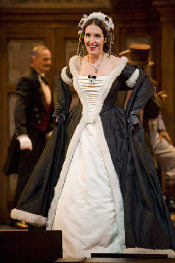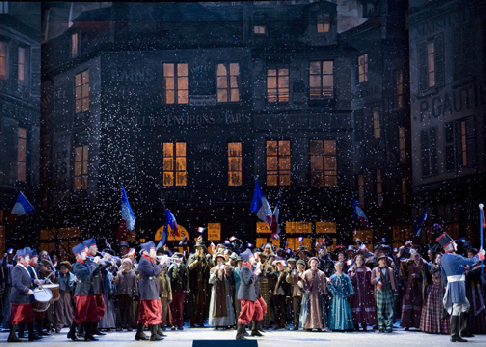25 Nov 2008
La Bohème in San Francisco
The show curtain was an illustration of the typical Parisian skyline.

The show curtain was an illustration of the typical Parisian skyline.
On the downbeat it quickly parted to reveal a scenic contraption that was a garret of sorts, its mattress elevated on a pile (illustrated, not real) of books, and an admonition written on the wall Se plaindre c’est un perdre du temps (for those of the audience who didn’t know French or were sitting too far away to read it, this told us that complaining is a waste of time).
So, let us not waste time on what we found lacking, and get right to what we liked. San Francisco Opera Music Director designate, Nicola Luisotti, participated with every syllable uttered on the stage, literally quivered with every emotion, and wrenched very grand pathos out of Puccini’s sad little story. Donald Runicles’ San Francisco Opera Orchestra responded full bore to their new maestro with renewed lyricism and resplendent tone proving itself again one of the world’s fine operatic ensembles.
Moments of extraordinary verismo abounded. The monochromatic tenor of Piotr Beczala made sudden sense in the third act when Mo. Luisotti orchestrally evoked the naïve, adolescent recognition of new feelings by what seemed to be an emotionally retarded tenor. The fourth act duet of reconciliation shivered with tiny flashes of love, and finally the sudden, overwhelming orchestral cry, joined by that of Rodolfo, shattered the silence of death.
 Norah Amsellem (Musetta)
Norah Amsellem (Musetta)
Back at the first act, Mimi and Rodolfo sustained full throated high “C’s” offstage as the garret contraption disappeared into kinetic openness of a Parisian place. Illustrated hotels de la ville materialized in front of our eyes in a surprisingly simple, and pleasing a vista transformation of scene. The Cafe Momus later materialized much less elegantly, to become populated suddenly and a little strangely by a noisy crowd of youngsters — the amazing San Francisco Boys Chorus (with some members of the San Francisco Girls Chorus) singing boisterously and joyfully, and always on the beat.
The big house extravagance of a real marching band (two drums, four trumpets, two piccolos) parading noisily across the stage at the end of Act II was deeply satisfying too. Some of the best Boheme’s understandably occur in provincial theaters where resources are usually as humble as are the opera’s protagonists, and where it is far more cost efficient to render this lively musical climax from the pit.
If Maestro Luisotti gave us the very real if overscaled emotions of verismo, Angela Gheorghiu gave us simplicity itself as the ill-fated Mimi. She was the evening’s only believable and real character, achieved by la Gheorghiu with true artistry, artistry that often tested, and sometimes even teased her considerable, sophisticated vocal technique. Madame Gheorghiu (she is an officier de l’Ordre des Arts et des Lettres) indeed creates a vocally complex Mimi. That it is so physically manifest (acted out) is another matter, understandably irritating to the uninitiated, and irritating to stage directors who are almost universally not among her fans.
One can only sympathize with Mme. Gheorghiu in her trials with Lyric Opera of Chicago regarding an AWOL from her Chicago Boheme manquée rehearsals to visit Roberto who was singing Faust just then at the Met (if there is possibly anyone who does not yet know, the French tenorissimo Roberto Alagna is her husband). As Mme. Gheorghiu knows, Mimi is the calm center of the maelstrom of emotions that are La Boheme. What more is there for her to do than walk on stage at the end of Act I and sit on the bed while Rodolfo sings, sit at a table at the Cafe Momus while Musetta sings, hover in the background in Act III while Rodolfo and Marcello sing, and lie in bed in Act IV while her friends emote one by one. Quite obviously it is Mimi’s friends, not Mimi, who need rehearsal time as they are the ones who complete the show.
 Scene from Act II
Scene from Act II
These San Francisco Opera performances of La Boheme (the last one will mark the two hundred twenty third SFO performance of Puccini’s little opera) bare the delicacy of this masterpiece when attempted with extravagant operatic resources. In San Francisco the problem was integrating smaller scale artists — singers, directors and designers - with great artists and with grand opera scale choral, orchestral and technical resources.
Michael Milenski